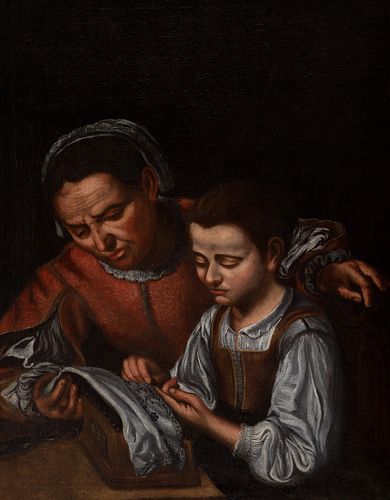Flemish school; first half of the 17th century. "Education of the Virgin". Oil on canvas. Measurements: 82,5 x 65 cm; 104 x 86 cm (frame).
Lot 103
About Seller
Setdart Auction House
Carrer Aragó 346
Barcelona
Spain
Setdart Subastas was born in 2004 and is currently the first online art auction in Spain with solidity, prestige and reliability guaranteed by our more than 60,000 users. Setdart has a young, dynamic and enterprising team ready to successfully manage the purchase and sale of art works through custom...Read more
Estimate:
EUR€20,000 - EUR€25,000
$20,833.33 - $26,041.67
Absentee vs Live bid
Two ways to bid:
- Leave a max absentee bid and the platform will bid on your behalf up to your maximum bid during the live auction.
- Bid live during the auction and your bids will be submitted real-time to the auctioneer.
Bid Increments
| Price | Bid Increment |
|---|---|
| EUR€0 | EUR€10 |
| EUR€200 | EUR€25 |
| EUR€500 | EUR€50 |
| EUR€1,000 | EUR€100 |
| EUR€3,000 | EUR€200 |
| EUR€5,000 | EUR€500 |
| EUR€10,000 | EUR€1,000 |
| EUR€20,000 | EUR€2,000 |
| EUR€50,000 | EUR€5,000 |
About Auction
By Setdart Auction House
Oct 20, 2021
Set Reminder
2021-10-20 07:30:00
2021-10-20 07:30:00
America/New_York
Bidsquare
Bidsquare : OLD MASTERS
https://www.bidsquare.com/auctions/setdart-auction-house/old-masters-7700
Setdart Auction House sofia@setdart.com
Setdart Auction House sofia@setdart.com
- Lot Description
Flemish school; first half of the 17th century. "Education of the Virgin". Oil on canvas. Measurements: 82,5 x 65 cm; 104 x 86 cm (frame). In a dark interior the author poses a completely intimate scene. In it we can see how a mother is going over the sewing work of her little daughter. Both are concentrating on their activity, looking at the fabric being embroidered by the child. Their active attitudes towards the work are defined by a serious gesture that harmonises with the sobriety of the scene. At first glance, the image seems to reflect an everyday moment, typical of a 17th-century mother-child relationship. However, this genre scene conceals much more, bringing the viewer closer to a religious theme through an image inspired by the society of the time. In such a way that the artist manages to create an empathy between the viewer and the subject, thus bringing religion closer to the faithful. The iconography that alludes to Saint Anne and the Virgin first appeared at the end of the Middle Ages and became popular from the 16th century onwards, with the book appearing as an attribute of Saint Anne from that time onwards. This subject was the focus of intense discussion in intellectual circles in Seville during the Baroque period. As part of the Counter-Reformation doctrine, the Church dictated a series of rules to painters aimed at regulating the treatment of the most fundamental themes of Catholic doctrine so that they could be understood by the people. In particular, the Virgin became one of the most popular subjects among the Catholic faithful, as her immaculate conception was questioned by Protestants. Hence the proliferation in the 17th century of cycles of the Virgin's life, one of the scenes of which concerns her education. Although this theme aroused controversy among intellectuals, because it cast doubt on Mary's perfection, it was very much to the taste of the people because of its human and realistic character. The technical characteristics of the work, such as the range of earthy tones, the attitudes of the main characters, and the influence of a genre aesthetic, suggest certain connections with the work of the artist Michael Sweerts (Brussels, 1618 - Goa, India, 1664). It should also be noted that there is a work by Michael Sweerts very similar to the one presented here, now in the Metropolitan Museum, New York (reproduced in R. Kultzen, "Michael Sweerts (1618-1664)", 1996, fig. 162, cat. no. R6). There are indications that Michael Sweerts may have resided in the city from 1646, two years earlier. Until 1651 he lived in Via Marguta, in the area where several of the Bamboccianti lived, including Pieter van Laer. This school was to exert a powerful influence on Sweerts's art, although he distanced himself from it through more idealised models and, in particular, through a precious and virtuoso treatment of light, related to the Dutch interior painters. An eloquent example of this period is "Boy with a Turban and a Bouquet of Flowers" (Madrid, Museo Thyssen-Bornemisza). He was also associated with the contemporary Roman school, as evidenced by the fact that he attended the meetings of the Accademia di San Luca in 1647, albeit only as an associate, as he was never a member. During his years in Rome Sweerts combined painting with commercial assignments, representing the Duetz family, a wealthy merchant family in Amsterdam, some of whose members he portrayed in Rome. He also worked in the Italian capital for Prince Camillus Pamphili, nephew of Pope Innocent X. We know that in 1652 he was still in Rome, as can be seen in his signed and dated work "Painter's Studio" (Detroit, Institute of Arts). After these years in Rome, Sweerts returned to Brussels, where he is recorded in 1656, and founded a drawing academy there.
- Shipping Info
-
In-house shipping available. Please inquire at admin@setdart.com.
-
- Buyer's Premium



 EUR
EUR CAD
CAD AUD
AUD GBP
GBP MXN
MXN HKD
HKD CNY
CNY MYR
MYR SEK
SEK SGD
SGD CHF
CHF THB
THB









